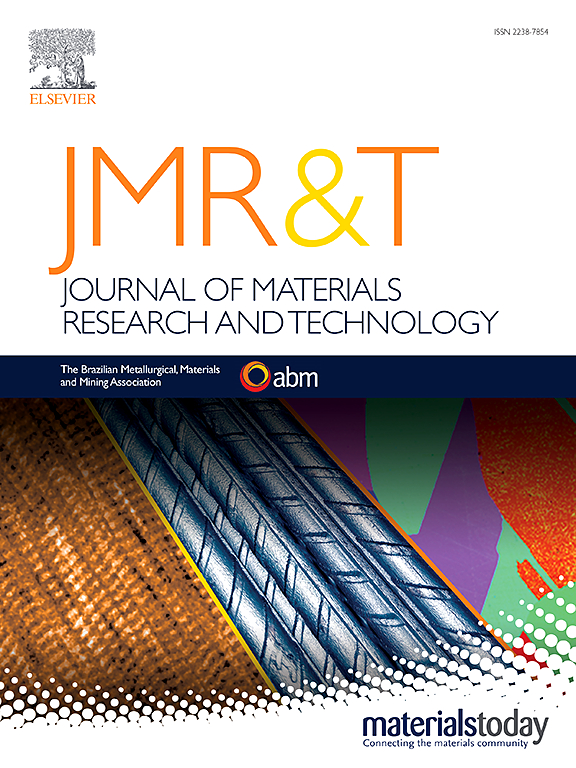激光微合金化下添加mo Ti6Al4V合金的显微组织及亚稳相形成
IF 6.6
2区 材料科学
Q1 MATERIALS SCIENCE, MULTIDISCIPLINARY
Journal of Materials Research and Technology-Jmr&t
Pub Date : 2025-06-11
DOI:10.1016/j.jmrt.2025.06.072
引用次数: 0
摘要
了解增材制造过程中合金元素对ti基合金凝固阶段的影响对后续的组织控制和成分优化至关重要。本文采用激光微合金化(LMA)技术来保持合金的初始凝固组织。首先对激光微合金化工艺参数进行优化,然后选择工艺参数(2400 W, 0.2 s)制备Ti6Al4V- xmo (x = 0 ~ 8 wt%)试样,研究Mo含量对Ti6Al4V显微组织的影响。结果表明,随着Mo含量的增加,合金的组织由均匀分布演变为独特的细胞形态,这与细胞内部Mo的富集有关。抑制了β相向α/α′相的转变,最终形成以β相为主的微观组织。重要的是,Mo含量的增加导致α″相比例的增加,这是由于较大的晶格畸变使得原子迁移更加困难,有利于bcc-β相转变为正交-α″相。合金显微硬度呈现先升高后降低的趋势,非均相导致硬度分布不均匀。这项工作为激光增材制造中添加mo的Ti6Al4V合金的微观结构形成和调控提供了理论见解。本文章由计算机程序翻译,如有差异,请以英文原文为准。
Microstructure and metastable phase formation of Mo-added Ti6Al4V alloys under laser micro-alloying
Understanding the influence of alloying elements on the solidification stage of Ti-based alloys during additive manufacturing (AM) is crucial for subsequent microstructural control and composition optimization. In this work, a laser micro-alloying (LMA) technique is employed to retain the initial solidification microstructure of the alloys. The laser micro-alloying parameters are first optimized, after which Ti6Al4V-xMo (x = 0–8 wt%) samples are fabricated using a selected processing parameter (2400 W, 0.2 s) to investigate the influence of Mo content on the microstructure of Ti6Al4V. The results indicate that as the Mo content increases, the alloy's microstructure evolves from a uniform distribution to a distinctive cellular morphology, which is attributed to the enrichment of Mo in the cell interior. The transition from the β phase to the α/α′ phases is inhibited, ultimately resulting in a microstructure predominantly composed of the β phase. Importantly, the increase in Mo content induces a higher proportion of the α″ phase, which is due to the larger lattice distortion that makes atomic migration more difficult and favors the transformation of the bcc-β phase into the orthorhombic-α″ phase. Furthermore, the microhardness of the alloy exhibits a trend of initial increase followed by a decrease, with heterogeneous phases contributing to uneven hardness distribution. This work provides theoretical insights into the microstructure formation and regulation of Mo-added Ti6Al4V alloys in laser additive manufacturing.
求助全文
通过发布文献求助,成功后即可免费获取论文全文。
去求助
来源期刊

Journal of Materials Research and Technology-Jmr&t
Materials Science-Metals and Alloys
CiteScore
8.80
自引率
9.40%
发文量
1877
审稿时长
35 days
期刊介绍:
The Journal of Materials Research and Technology is a publication of ABM - Brazilian Metallurgical, Materials and Mining Association - and publishes four issues per year also with a free version online (www.jmrt.com.br). The journal provides an international medium for the publication of theoretical and experimental studies related to Metallurgy, Materials and Minerals research and technology. Appropriate submissions to the Journal of Materials Research and Technology should include scientific and/or engineering factors which affect processes and products in the Metallurgy, Materials and Mining areas.
 求助内容:
求助内容: 应助结果提醒方式:
应助结果提醒方式:


